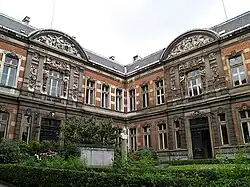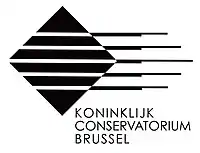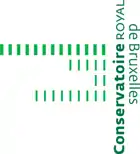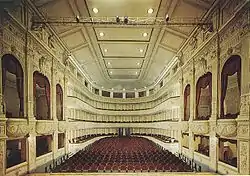Royal Conservatory of Brussels
The Royal Conservatory of Brussels (French: Conservatoire royal de Bruxelles, Dutch: Koninklijk Conservatorium Brussel) is a historic conservatory in Brussels, Belgium. Starting its activities in 1813, it received its official name in 1832. Providing performing music and drama courses, the institution became renowned partly because of the international reputation of its successive directors such as François-Joseph Fétis, François-Auguste Gevaert, Edgar Tinel, Joseph Jongen and Marcel Poot, but more because it has been attended by many of the top musicians, actors and artists in Belgium such as Arthur Grumiaux, José Van Dam, Sigiswald Kuijken, Josse De Pauw, Luk van Mello and Luk De Konink. Adolphe Sax, inventor of the saxophone, also studied at the Brussels Conservatory.
 Royal Conservatory of Brussels | |
| Type | Public Higher School of Arts (French-speaking entity) School of Arts under Erasmus University College (Dutch-speaking entity) |
|---|---|
| Established | 1813 |
| Affiliation | WBE (French-speaking entity) EhB (Dutch-speaking entity) |
| Director | Peter Swinnen (Flemish entity) Frédéric de Roos (French entity) |
| Location | , |
| Website | www www |
  | |
In 1967, the institution split into two separate entities: the Koninklijk Conservatorium Brussel, which teaches in Dutch, and the Conservatoire royal de Bruxelles, which continued teaching in French. While the French-speaking entity remained an independent public institution of higher education (École supérieure des arts), the Flemish entity integrated into the newly created Erasmus University College as one of its Schools of Arts.
Building
The current Royal Conservatory building consists of three wings arranged around a courtyard and is the work of architect Jean-Pierre Cluysenaer, built to his designs between 1872 and 1876.
The style is neo-Renaissance, influenced by the Lescot Wing of the Louvre. The decorative program of the facade is very elaborate, with five separate pediment sculptures (Instrumental Music by Liège sculptor Adolphe Fassin, Orchestration by Charles van der Stappen, Composition by Antwerp sculptor Frans Deckers, Performing Arts by Antoine-Félix Bouré, and Poetry by Tournai sculptor Barthélemy Frison) and other incidental work including garlands, caryatids, palm trees and musical instruments by sculptors Georges Houtstont, Paul de Vigne, Antoine-Joseph Van Rasbourgh, Auguste Braekevelt, and Égide Mélot.
Auxiliary activities
Concerts
Each year a variety of regular student concerts and performances is organised by the Conservatory, boasting over hundred events and enhanced by two festivals.
The right wing of the Conservatory contains a 600 seats ornate concert hall in Napoleon-III style with exceptional acoustic qualities, equipped with a Cavaillé-Coll organ.

Musical Instrument Museum (MIM)
Founded in 1877 to provide students with a practical education about ancien instruments, the Conservatory museum, currently referred to as the Musical Instrument Museum (MIM) of Brussels displays over 8,000 ancient instruments acquired by the celebrated musicologist François-Joseph Fétis, rare pieces from the initial collection, from the various funds or from new acquisitions. Since 2000, the museum, one of the most important ones of its kind, is located in the prestigious Art Nouveau building conceived in 1899 by the architect Paul Saintenoy for the former Old England department store.
Library
Initially created with a pedagogic aim, the Conservatory library hosts about 250,000 references, representing a scientific instrument of international resonance.

It primarily consists of works about music (including more than 1200 musical or musicological periodicals), as well as of autograph, printed or digitized (scanned) scores. There is also an important collection of more than 8.000 libretti of Italian, French or German operas from the XVIIe and XVIIIe s., lute and guitar tablatures, several thousands of handwritten letters of musicians, iconographic documents (over 9.000 pieces), concert programmes and various types of recordings (magnetic tapes, video, 78 and 33 rpm vinyl, CD, etc.).
Next to the core collections, the library possesses several subcollections of historical importance, together forming an extensive patrimony:
- the Johann J.H. Westphal collection bought by Fétis (manuscripts of C.P.E. Bach and G.P. Telemann),
- the Richard Wagener collection acquired by the librarian Alfred Wotquenne (German music from the XVIIe, XVIIIe and XIXe s. including 40 autograph manuscripts from three sons of J.-S. Bach),
- the Jean-Lucien Hollenfeltz collection (documents of Constance Mozart and her youngest son Franz Xaver Amadeus Mozart),
- the Maria Malibran collection (documents and objects from the cantatrice and her close family),
- the Edmond Michotte collection (pieces from Rossini's private library),
- the Józef Wieniawski collection (autograph scores from the pianist),
- the Laurent Halleux collection,
- the Joseph Jongen collection.
The library is open to the general public. In 2015, the library acquired the score collection of CeBeDeM (Belgian Centre for Music Documentation). In doing so it also took over the latter's objectives in promoting Belgian contemporary music worldwide.
Personalities linked to the Royal Conservatory of Brussels
_(14783631813).jpg.webp)
Directors
- 1833–1871: François-Joseph Fétis
- 1871–1908: François-Auguste Gevaert
- 1908–1912: Edgar Tinel
- 1912–1925: Léon Du Bois
- 1925–1939: Joseph Jongen
- 1939–1949: Léon Jongen
- 1949–1966: Marcel Poot
Directors of the Conservatoire Royal de Bruxelles
- 1966–1973: Camille Schmit (in French)
- 1974–1987: Éric Feldbusch (in French)
- 1987–2002: Jean Baily (in French)
- 2003–present: Frédéric de Roos
Directors of the Koninklijk Conservatorium Brussel
- 1966–1994: Kamiel D'Hooghe (in Dutch)
- 1994–2004: Arie Van Lysebeth (in Dutch)
- 2004–2008: Rafael D'haene
- 2008–2017: Peter Swinnen
- 2017–2021: Kathleen Coessens
- 2021–present: Jan D'haene
Notable faculty
- Charles-Auguste de Bériot, violin
- Daniel Blumenthal (piano)
- Lola Bobesco (violin)
- François Daneels, saxophone
- Luc Devos (piano)
- Paul Dombrecht (oboe)
- François Fernandez (baroque)
- Bernard Foccroule, organ
- Julien Ghyoros, direction
- Katarina Glowicka, computer music
- Philippe Graffin, violin
- Yossif Ivanov (violin)
- Barthold Kuijken (baroque)
- Jacques Leduc (direction, composition)
- Jacques-Nicolas Lemmens, organ
- Jean Louël, piano
- Jan Michiels (piano)
- Norbert Nozy (brass band)
- Igor Oistrach (violin)
- Philippe Pierlot (baroque)
- Marie Pleyel, piano
- Eliane Reyes, piano
- Adolphe Samuel, composition
- Adrien François Servais (cello)
- André Souris (direction, composition)
- Annelies Van Parys, form analysis
- Henri Vieuxtemps, violin
- Boyan Vodenitcharov (piano)
- Henryk Wieniawski, violin
- Eugène Ysaÿe, violin
- Juliusz Zarębski, piano
Notable alumni
- Isaac Albéniz
- Elie Apper
- Atar Arad
- Oskar Back
- Peter Benoit
- Fabrizio Cassol
- Claire Chevallier
- Alain Crépin
- François Daneels
- Lara Fabian
- Gianfranco Pappalardo Fiumara
- John Giordano
- Edwin Grasse
- Mansoor Hosseini
- Albert Huybrechts
- Anthony Jennings[1]
- Désiré Magnus
- Alma Moodie
- Norbert H. J. Nozy
- André Rieu
- Elsa Ruegger
- Noël Samyn (fr)
- Adolphe Sax
- Celia Torra
- José van Dam
- Carl Verbraeken
- Aimee Wiele
- Alfred Wotquenne
- Eugène Ysaÿe
References
- J.M. Thomson (20 January 2001). "Jennings, Anthony". Grove Music Online (8th ed.). Oxford University Press. doi:10.1093/gmo/9781561592630.article.42592. ISBN 978-1-56159-263-0.
External links
- Koninklijk Conservatorium Brussel
- Conservatoire Royal de Bruxelles
- Erasmus University College
- Arts Platform Brussels
- http://www.lacambre.be
- http://www.insas.be
- Royal Conservatory of Brussels library catalog
- CeBeDeM
- Virtual exhibition : La collection de manuscrits de Georg Philipp Telemann (1681-1767) à la Bibliothèque des Conservatoires royaux de Bruxelles (French only)